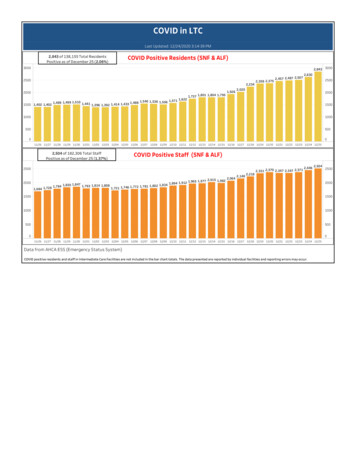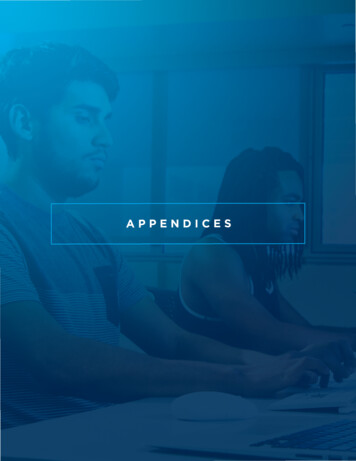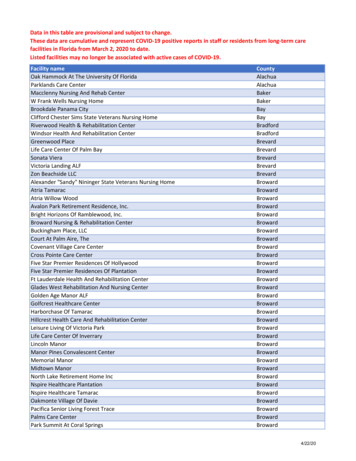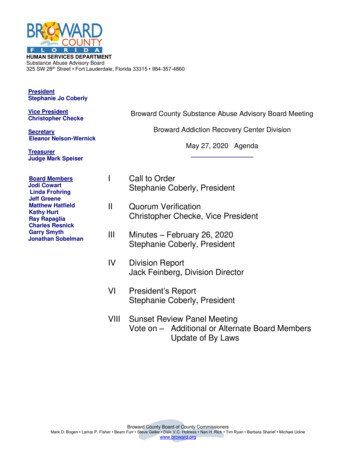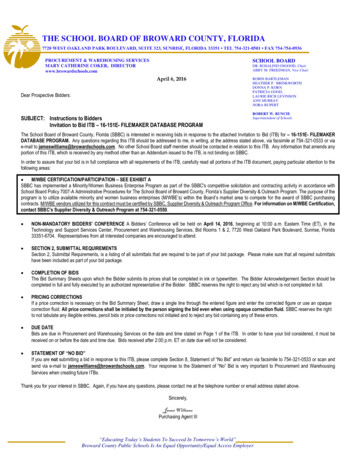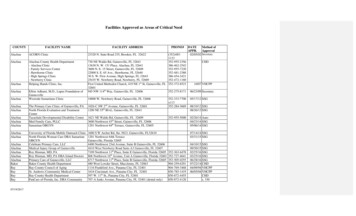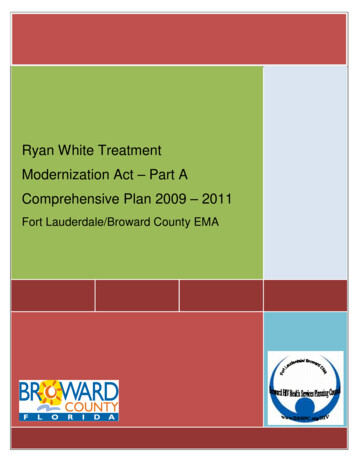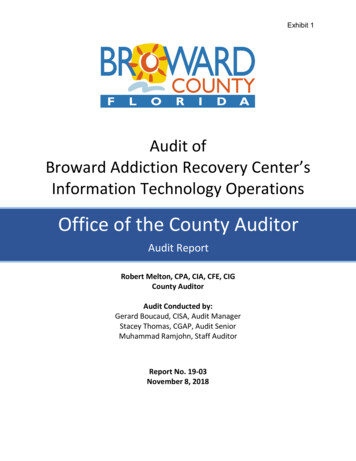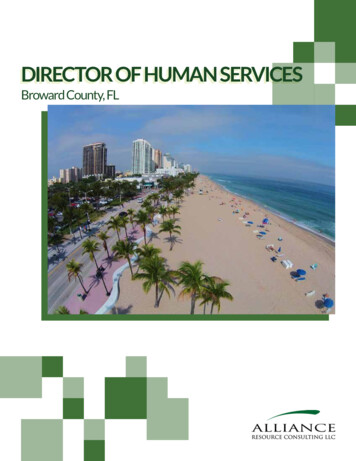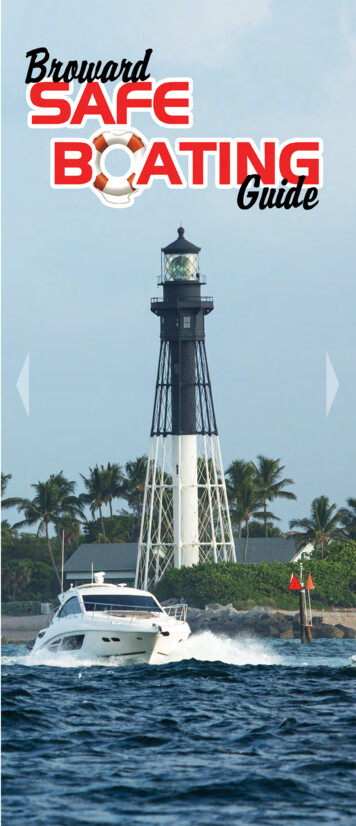
Transcription
A Handbook of Boating Laws andGuidelines for Safe Operation
Published by the United States Power Squadrons pursuant to a grant provided by the Broward CountyBoard of County Commissioners throughrecommendations of its Marine Advisory Committee.Copyright 2016. All rights reserved. No part of thispublication may be reproduced in any form or by anyprocess without the express written permission fromUnited States Power Squadrons . An effort has beenmade to make this publication as complete, accurate,and current as possible. All references contained in thispublication have been compiled from various sourcesbelieved to be current and reliable; however, thisdocument is a guide only. This document does notreplace the applicable statutes, regulations, andstandards for boating in Florida. Boating laws andregulations may be amended over time, which couldaffect a particular procedure, issue, or interpretationpresented in the publication. Boating, even under thebest conditions, presents risks of serious injury or evendeath. The operator of a vessel is ultimately responsiblefor the vessel and the safety of all persons aboard. Theinformation in this publication is intended to assistoperators in making correct and safe decisions;however, there is no substitute for good andresponsible judgment. Neither United States PowerSquadrons nor Broward County assumes responsibility for errors and omissions nor is either party liablefor any claims, liabilities, damages, or other adverseeffects or consequences to any person or propertycaused or alleged to be caused directly or indirectlyfrom the application, use, or misuse of the informationcontained in this publication.
Table of ContentsWelcome and Introduction.1Boating Safety Courses.2Boating Safety Tips.3Registration Information.4Safety Equipment Requirements.10Fire Suppression – Fire Extinguishers.12Signals:Visual and Sound.14Navigation Lights.18Anchors: Types and Techniques.21Communications:VHF Radios/Cell Phones.23Knots and Lines.26Sanitation and Garbage.29Ventilation.30Trailering.31Digest of Local Information.35Port Everglades Inlet.37Submarine Training Area.39Map.InsertWaterway Drawbridge Guide.41Boating Safety and Manatee Protection Zones.43Operating Procedures.43Docking and Undocking, Lines, Fenders, Boathooks.46Operating Procedures.50Weather.55What to Do in Severe Weather.58Hurricanes.59Customs Requirements and Float Plans.62Sample Float Plan.66Diving.68Law Enforcement.69Other Vessels.72Public Boat Ramps.74Broward County Pumpout Facilities.79
Welcome and IntroductionBroward County is rightfully known as theYachting Capital of the World. Nestled in theheart of South Florida, our boaters can accessbeautiful coastline, miles of inland waterways withrivers and lakes, the Intracoastal Waterway (ICW),and the Everglades. The State of Florida ranksthird in the nation for the number of registeredpleasure craft. Mega-yachts, kayaks, power boats,sailing vessels, wooden skiffs, and paddleboards areas normal as having a car for some Floridians.Boating is big business in Broward County.Broward County’s marine industry representsa total economic output of 8.8 billion andprovides more than 110,000 jobs.As a boat operator, you are expected to makesure that your vessel carries the required safetyequipment (carriage requirement) and is incompliance with federal and state regulationsfor such things as numbering and operation.This publication contains information aboutfederal and state laws as well as equipmentcarriage requirements for recreational vessels ofthe United States. It is important to understandthat federal and state equipment requirementsare minimums and do not guarantee the safetyof your vessel or its passengers.In the following sections, we have also providedrecommendations for additional safety equipmentyou may wish to have on board. A vessel incompliance with the laws of the state ofregistration may not meet the requirements ofanother state where the vessel is being operated.This guide provides boaters with information formore enjoyable boating. Other topics includeboating safety, navigation, boat handling, trailering,equipment, and Florida weather.ANYONE BORN ON OR AFTERJANUARY 1, 1988, WHO OPERATES AMOTORIZED BOAT OF 10 hp OR MORE ISREQUIRED TO OBTAIN A FLORIDABOATING SAFETY EDUCATION I.D. CARDAND MUST POSSESS PHOTO ID.1
Boating Safety Courses –Become an Educated BoaterBoating Safety Classes are taught throughoutthe year by the United States PowerSquadrons and the U.S. Coast GuardAuxiliary Flotillas.The list below has contactinformation for these organizations.United States Power Squadrons Pompano Beach Sail & Power SquadronUSPS.org/Pompano/3701 N.E. 18th TerracePompano Beach 33064954-782-7277Hollywood Power ?Hollywood954-983-6214Coral Ridge Sail & Power t Lauderdale Power SquadronFLPowerSquadron.org5225B W. Broward Blvd., Plantation 33317954-533-7854U.S. Coast Guard AuxiliaryUSCGAux.orgFlotilla 3-2, Fort Lauderdale – 954-463-0034,uscgaux32@gmail.comFlotilla 3-4, Pompano Beach – tilla 3-7 Lighthouse Point – 731-907-0307,courses@aux37.orgFlotilla 3-8 Plantation – 954-214-5653,fsocs@flsafeboating.orgBoater Education – It’s The Law!2
Anyone born on or after January 1, 1988, must have aBoating Safety Education ID Card to legally operate amotorized boat of 10 hp or more in Florida.To obtain acard, a person has to successfully complete a NationalAssociation of State Boating Law Administrators (NASBLA)-approved boating safety course. For more informationcontact the Florida Fish and Wildlife ConservationCommission at 850-488-5600 or emailbobbercard@myfwc.com.Boating Safety Tips From theBroward County Sheriff Complete a boating education course. One ofthe primary factors contributing to vesselaccidents is operator inexperience. Get your boat checked for safety’s sake. TheVessel Safety Check (VCS) is a free publicservice offered by the United States CoastGuard Auxiliary and the United States PowerSquadrons volunteer organizations. Always wear a United States Coast Guard-approved life jacket and make sure all of yourpassengers wear one, too. Avoid alcoholic beverages while boating. Morethan one-third of all boating deaths result fromcollisions involving alcohol use. Be aware of weather conditions beforeheading out on the water and know what to doif the weather suddenly changes. Have a working marine radio on board at alltimes and know how to use it. Pack extra gear you may need. A flashlight withfresh batteries, flares, a first-aid kit, sunscreen,and drinking water are a few items that shouldbe packed in a watertight container that floats. Tell someone where you are going, who is withyou, and how long you plan to be out, then stickto your travel plans. Ventilate after fueling. Open hatches, run theblower, and check for fuel fumes before startingthe engine. Know your boat’s capacity and how to properlyload it. An overloaded or improperly loadedboat can cause safety problems.All children under the age of 6 in a vessel under26 feet long must wear a United States CoastGuard-approved life jacket while boating in Floridawaters, and up to three miles from shore.3
Registration InformationMethod of RegistrationAll vessels operated on the waters of Floridamust be registered and/or numbered inFlorida except as follows: Vessels used exclusively on private lakesor ponds. Vessels owned by the FederalGovernment. Vessels used exclusively as lifeboats. Non-motorized vessels. Vessels with a current registrationnumber from another state or fromanother country temporarily using Floridawaters (less than 90 consecutive days).Note: Owner of such vessels might begranted the option of remaining in Floridawaters for a longer period without the needfor reregistration providing their presentregistration or documentation remains infull force during their stay, they complete aSojourner Registration Form and payappropriate fees as may be acceptableto the Florida Department of HighwaySafety before an initial 90-day stay wouldexpire and would otherwise be allowableunder Florida Statute Section 328.58.Floriday Safetyt of HighwaDepartmenVehiclesand MotorDivision ofSUBJECT:EPROCEDURVSRS-09ON ANDDESCRIPTISOJOURMotor VehiUSE:ON AND INSINFORMATIPROVIDESCEDURETHIS PROISTRATIONNER REGA SOJOURII.FORTRUCTIONSANCE OFTHE ISSUacovered byel alreadyOF LAW:by the USer of any vess by another state ors that the ownst Guard forawardedStatutes, state ct which has beenor the US Coa her stateeffeng system.58, FloridaanotSection 328full force and rally approved numberi force and effect from ss of thenumber inexcein fulla fedeinionoutstateregistrationstratwitha valid regi el on the waters of thisrd in a stateCoast Guavessel withating the vessdocumentedprior to opera federallythe numbershall recordod.procity peri:90-day recilyTRUCTIONSoffice to appCIAL INSSPEcollector'sATION ANDto the taxDOCUMENTdocumentsfollowingsubmit thetospletedneedntrately comThe applica er Registration:Vessels," accudurnTitlefor a SojoRegister Nonplication toV 87244, "Apber andForm HSMA.of-state numlicant.existing outby the appto record theregistrationout-of-state.theonlylofydecaA copissue aB.system toallow theida forain in Florfees.ers who remwith them.Registrationthe vesselvessel ownC.ed to thosestate and takeions are issu return to their homeforurner registratnd tois being usedNOTE: Sojo than 90 days, but inteif the vessel mption:gedcharmoreis(Exeel feemercial vess is a non-resident or alien mping from theent/alien comownermercial shri 50 non resid oses and the vesselely for comusivNOTE: Aexclpurpidents usedcommercialed by non-res Carolina and Texas.)thVessels ownsissippi, NorPAGE #states of MisVSRS-09-01DATEREVISION03/15/02E DATEEFFECTIV07/01/97SPROVISIONI.clesISTRATIONNER REGDIREDIVISIONHSMV 8000CTOR14
In addition, all vessels, except documentedvessels and non-motorized boats less than16 feet in length, must be titled in Florida.Apply for your title and registration with theFlorida Department of Revenue. When submittingthe application, you must provide proof of vesselownership by submitting an executed bill of sale,a builder’s contract, a manufacturer’s statement oforigin, a federal marine document, or other documents acceptable to the Department of HighwaySafety and Motor Vehicles.The registration must be renewed each year onyour birthday. The annual fees in Broward Countyeffective since September 1, 2015, are as follows:Class A-1 (less than 12’ and all motor-poweredcanoes regardless of length). 13.00Class A-2 (12’ to less than 16’) . 29.13Class 1 (16‘ to less than 26’) . 47.88Class 2 (26‘ to less than 40’) . 122.13Class 3 (40‘ to less than 65’) . 196.38Class 4 (65‘ to less than110’) . 233.88Class 5 (110‘ and over) . 289.38Dealer Classification . 30.25Included in the above is a service fee of 2.25and a .50 FRVIS fee. The fee for titling a vesselis 5.25. To title a vessel, you must show proofof payment of sales tax for the vessel, motor, andtrailer. Properly registered vessels and outboardmotors capable of powering such vessels areexempt from personal property tax.NOTE: The above-listed fees are calculated toinclude additional registration fees imposed byBroward County, which are retained and used bythe County for boating-safety purposes.5
Upon receipt and approval of your registration,you will be issued a certificate of number and avalidation decal. The certification of number ispocket-sized and must be on board whenever theboat is used. The boat’s number must be properlydisplayed as follows: The figures are read from left to right. They must be displayed on the forward halfof each side of the boat. Numbers must be bold, block letters ofreadable proportion. Numbers must not be less than three incheshigh. They must be of contrasting color to theboat hull or background. They must be as high above the waterline aspractical. No number other than the number assignedcan be displayed on the forward half of thevessel. Letters must be separated from numbers byspaces or hyphens. Validation decals must be displayed within sixinches of the number display on the port side.State Validation StickerPlace before OR after the numbers,according to your state requirements.FL 1234 ABFL 1234 AB3"FL 1234 ABFL 1234 ABFL 1234 ABFlorida law requires titling of most undocumentedmotorboats and non-motor-powered vesselsmore than 16 feet in length.Documented BoatsOwners of larger boats can document theirvessels with the U.S. Coast Guard. A marinedocument is proof of ownership and is recognizedinternationally. If you have a documented boat foruse in Florida, you must still register it in Florida.Documented vessels must display the validationdecal on the windshield or port window.6
Hull Identification NumberAll boats built after 1972 must have a HullIdentification Number (HIN) permanentlyattached to the transom on the starboard side,above the waterline. If you have a homemade boat,you should contact the Department of HighwaySafety and Motor Vehicles for a hull identificationnumber. The number is like a serial number on acar. A new regulation in 1984 requires this HIN tobe permanently attached in a second, unexposedlocation. Record your number, and keep it in asafe place away from the boat; it may assist you inidentifying your boat should it be stolen. Also, itwill be necessary to have the HIN to numberyour boat in most states.Additional Registration Information Florida has an antique vessel registrationprogram that allows for special registration fornoncommercial vessels at least 30 years old andpowered by the vessel’s original power plant.Contact the Department of Highway Safety andMotor Vehicles for more information. An additional 50 commercial vessel fee isrequired of all nonresidents or aliens. For the first-time boat registration, if yourbirthday is less than a year from the time youregister your boat, your fee will be prorated.Also for the first-time registration, if yourbirthday is within three months of your boatregistration date a 15-month boat registrationis available. If you change your address; if your boat isdestroyed, lost, or sold; or if you abandon yourvessel, you must notify the Department ofHighway Safety and Motor Vehicles within 30days. In that notification, you must provide yournew address, the new ownership information,or the location and circumstances concerningthe destruction, loss, or abandonment of yourvessel.7
8
9
Safety Equipment RequirementsIntroductionA boat is more than a shell with some kind ofpropulsion to move it around in the water. Thereare many pieces of marine gear and other itemsin and on a boat that enhance the pleasure andsafety of boating. This section addresses thoseitems usually found aboard small boats, someof which are required by law. The United StatesCoast Guard sets minimum standards for recreational vessels and associated safety equipment.Personal Flotation Devices - PFD (Life Jackets)All recreational vessels must carry one wearablelife jacket for each person on board. Any boat 16feet and longer (except canoes and kayaks) mustalso carry one throwable (Type IV) device. Lifejackets should be worn at all times when thevessel is under way.10
A life jacket can save your life,but only if you wear it.Life jackets must be: U.S. Coast Guard-approved (check the label). In good and serviceable condition in unlockedand open compartments. Suspender/inflatable life jackets must be worn tobe counted (during an inspection). Appropriate size and type for the intended user. Properly stowed – out of the original packaging,easily accessible in emergency conditions. Throwables must be readily available on themain deck and within arm’s reach.Whistles and emergency lights are not required,but are a good idea to have with your life jacket.Tablets or pills and CO2 cartridges should beinspected and/or replaced every year.All children under the age of 6, in a vesselunder 26 feet, must wear a Coast Guardapproved life jacket while under way in Floridawaters, and up to three miles from shore.The Florida Law requires wearing life jacketswhen in engaged in the following activities: Water-skiing and other towed activities(use a type designed for water-skiing). Operating a personal watercraft or PWC(use a type designed for water-skiing or PWC use). Sailboarding and kiteboarding.Florida Law requires life jackets and sound deviceson board canoes and kayaks, while the U.S. CoastGuard requires this equipment on paddleboards.Finding the right life jacket is critical for it to bethe most effective. Life jackets come in manydesigns, colors, styles, and materials. Some aremade to stand up to rugged water sports, whileothers protect the wearer for cold-watertemperature or special uses. Often boaterswear lighter jackets for inland and near shore,while more substantial ones are used for oceanactivities like deep-sea fishing. Be sure to chooseone that is appropriate for your body size,planned activities, and the water conditionsyou expect to encounter.11
Fire Suppression – Fire ExtinguishersU.S. Coast Guard-approved, marine-type fireextinguishers are required on boats where a firehazard could be expected from the engines or fuelsystem. Extinguishers are classified by a letter andnumber symbol. The letter indicates the type offire the unit is designed to extinguish. Type B, forexample, is designed to extinguish flaming liquids,such as gasoline, oil, and grease. The number indicates the amount of extinguishing agent containedin the extinguisher; the higher the number, thegreater the amount of agent in the extinguisher.The U.S. Coast Guard-approved extinguishersrequired for boats are hand-portable, have eitherB-I or B-II classification, and must be providedwith a mounting bracket. While not required, it isrecommended that the extinguishers be mountedin a readily accessible location. Consider locationswhere the extinguisher can be reached easily – forexample, at or near the steering station or in thegalley or engine room, but away from locationswhere a fire might likely start.12
The three classes of fire extinguishers are A, B,and C, to match the type of fire they extinguish: Class A fire: wood, paper, rubber, plastic, textiles. Class B fire: flammable liquids (gasoline, oil, andgrease). Class C fire: electrical equipment.A fire extinguisher will carry a label showing theclass of fire for which it is best suited.Fire extinguishers are required on boats when anyof the following conditions exist: There are closed compartments and compart-ments under seats where portable fuel tanksmay be stored. There are double bottoms not sealed to thehull or that are not completely filled withflotation materials. There are closed living spaces. There are closed stowage compartments, inwhich combustible or flammable materials arestored. There are permanently installed fuel tanks.(Fuel tanks secured so they cannot be moved incase of a fire or other emergency are consideredpermanently installed. Also, if the weight of a fueltank is such that persons on board cannotmove it, the U.S. Coast Guard may consider itpermanently installed.)Fire Extinguisher MaintenanceInspect extinguishers monthly to make sure that: Seals and tamper indicators are not broken ormissing. Pressure gauges or other indicators, if soequipped, read in the operable range asdescribed on the extinguisher. There is no obvious physical damage, rust,corrosion, leakage, or clogged nozzles.If the minimum weight is stated on the extinguisher label, weigh extinguishers annually to check.Fire extinguishers that do not satisfy the aboverequirements or that have been partially emptiedmust be replaced or taken to a qualified fireextinguisher servicing company for recharge.13
Required Number of Fire ExtinguishersThe following chart lists the number of fireextinguishers that are required on recreationalvessels. If a U.S. Coast Guard-approved fixed fireextinguishing system is installed for the protectionof the engine compartment, the required numberof extinguishers may be reduced in accordancewith the chart.Tip: Be careful when putting out galley fires.Too much pressure from the extinguisher cancause liquids or grease to spatter and spreadthe fire. Watch for hot embers and repeat if aflashback occurs.It is recommended that hand portable extinguishers be mounted in a readily accessible location.Signals: Visual and SoundAll boaters should be able to signal for help.Boaters must have U.S. Coast Guard-approvedday and night signals for vessels when required.Signaling devices are recommended whenoperating on all open bodies of water.Visual Distress SignalsVessels operating on U.S. coastal waters andterritorial seas, as well as those waters connecteddirectly, up to a point where the waterway is lessthan two nautical miles wide, must be equippedwith U.S. Coast Guard-approved visual distresssignals (VDS.) Vessels owned in the United States14
and operating on the high seas (three miles off ofthe Florida coast) must also be equipped with U.S.Coast Guard-approved visual distress signals.The following vessels are not required to carryday signals, but must carry night signals whenoperating from sunset to sunrise: Recreational boats less than 16 feet in length. Boats participating in organized events, such asraces, regattas, or marine parades. Open sailboats less than 26 feet in length thatare not equipped with propulsion machinery. Manually propelled boats.Pyrotechnic DevicesPyrotechnic visual distress signals must be U.S.Coast Guard-approved, in serviceable condition,and readily accessible.Check the expiration date. Expired signals maybe carried as extra equipment, but cannot becounted toward meeting the visual distress signalrequirement.Note: Flares are good for only 42 months fromthe date of manufacturing.Launchers manufactured before January 1, 1981,and intended for use with approved signals arenot required to be U.S. Coast Guard-approved aslong as they remain in serviceable condition.If pyrotechnic devices are selected, a minimum ofthree signals are required for day use and threesignals for night use. Some pyrotechnic signalsmeet both day- and night-use requirements(combination flares.)Pyrotechnic devices should be stored in a cool,dry place, if possible. A watertight containerpainted red or orange and prominently marked“DISTRESS SIGNALS” or “FLARES” isrecommended.U.S. Coast Guard-approved visual distress signalsand associated devices include: Pyrotechnic red flares, hand-held, or aerial(day/night use). Pyrotechnic orange smoke, hand-held, orfloating (day use).15
Launchers for aerial red meteors or parachuteflares.Each of these devices has a different operating/burning time. Check the label to see how longeach pyrotechnic device will remain illuminated.Choose a device best suited to the conditions inthe area where your vessel is typically used.Non-Pyrotechnic DevicesNon-pyrotechnic visual distress signals must bein a serviceable condition, readily accessible, andcertified by the manufacturer as complying to U.S.Coast Guard requirements. These signals include: The Orange Distress Flag Used as a day signal only. Must be at least 3 feet x 3 feet with a blacksquare and a ball on an orange background. Must be marked with an indication that itmeets U.S. Coast Guard requirements in 46CFR 160.072. Most visible when attached and waved on apaddle or boat hook, or flown from a mast. May be incorporated into devices designedto attract attention in an emergency, such asballoons, kites, or floating streamers. Electronic Distress Light Acceptable for night use only. Automatically flashes the international SOSdistress signal (· · · – – – · · ·). Must be marked with an indicator that itmeets U.S. Coast Guard requirements in 46CFR 161.013.16
Regulations prohibit displayof visual distress signalson the water under anycircumstances, except whereassistance is needed becauseof immediate or potentialdanger to persons on boarda vessel.All distress signals have distinct advantages and disadvantages. No single device isideal under all conditions orsuitable for all purposes.Pyrotechnics are universally recognized as excellentdistress signals, but thereis the possibility for injuryand property damage if nothandled properly. Thesedevices produce a very hotflame with the potential tocause burns and igniteflammable materials.Pistol-launched and handheld parachute flares andmeteors have manycharacteristics of a firearmand must be handled withextreme caution. In somestates and Canada they maybe considered firearms andprohibited from use. It isillegal to fire a flare in anon-distress situation.The following are just a fewof the many combinationsof devices that will meet therequirements: 3 hand-held red flares that are approved forday/night use. 1 hand-held red flare and 2 parachute flares forday/night use. 1 hand-held orange smoke signal and 2 floatingorange smoke signals for day and 1 electricdistress light for night.17
Navigation LightsRecreational vessels are required to display navigation lights between sunset and sunrise, and duringperiods of restricted visibility (fog, rain, haze, etc.)The U.S. Coast Guard Navigation Rules, International-Inland, specify lighting requirements forevery description of watercraft. The informationprovided below is for power-driven and sailingvessels less than 65.5 feet (20 meters) in length.Power-Driven VesselsFigure 1Figure 2If your power-driven vesselis more than 39.4 feet(12 meters) in length, itmust display navigationlights as shown in Figure 1.Figure 3If your power-drivenvessel is less than 39.4 feet(12 meters) in length, then itmust display navigation lightsas shown in Figure 2.For power-driven vessels less than 29.4 feet(9 meters) in length, the masthead or all-roundwhite light must be at least 3.3 feet (1 meter)above the sidelights.In a vessel of less than 65.6 feet (20 meters) inlength, sidelight may be displayed in a combinationlight as shown in Figure 2.18
Sailing VesselsIf your sailing vessel is less than 65.6 feet (20meters) in length, then it must display navigationlights as shown in Figures 3, 4, and 5.Figure 3Figure 4Figure 6Figure 5A sailing vessel of less than 23 feet (7 meters) inlength shall, if practicable, exhibit lights as shown.in Figure 6. If it does not, it shall have ready athand an electric torch or lighted lantern(flashlight) showing white light that shall beexhibited in sufficient time to prevent collision.Vessels Under OarsFigure 7A vessel under oars may exhibitthe lights for a sailboat. If it doesnot, it shall have ready at handan electric torch (flashlight) orlighted lantern showing a whitelight that shall be exhibited insufficient time to prevent collision.Note: Personal watercraft (PWC’s)cannot operate 30 minutes after sunsetand 30 minutes before sunrise.19
Lights and ShapesTo alert other vessels of conditions that may behazardous, there are requirements to display lightsat night and shapes during the day.Anchored VesselsAt night: All vessels at anchor must displayanchor lights. If your vessel is less than 164 feet(50 meters) in length, then its anchor light is anall-round white light visible where it can be bestbe seen from all directions.During the day: All vessels at anchor (powerdriven, sail, and sailing vessels under power) mustdisplay forward, where it can be best seen, a blackball shape.Vessels Restricted in Their Abilityto ManeuverNavigation Rules require vessels restricted in theirability to maneuver to display appropriate dayshapes (ball/diamond/ball) or lights. If the size ofthe vessel engaged in diving activities during theday make it impractical to display the day shapes,then it must exhibit a rigid replica of the international code flag “Alpha” not less than 3.3 feet(1 meter) in height to meet this requirement. Ifthe diving activities
pocket-sized and must be on board whenever the boat is used. The boat's number must be properly displayed as follows: The figures are read from left to right. They must be displayed on the forward half of each side of the boat. Numbers must be bold, block letters of readable proportion. Numbers must not be less than three .
